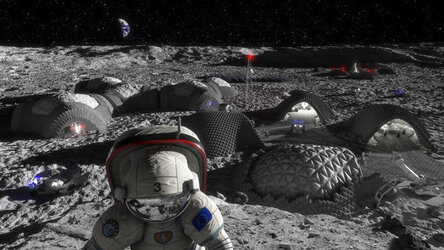Accept all cookies Accept only essential cookies See our Cookie Notice

About ESA
The European Space Agency (ESA) is Europe’s gateway to space. Its mission is to shape the development of Europe’s space capability and ensure that investment in space continues to deliver benefits to the citizens of Europe and the world.
Highlights
ESA - United space in Europe
This is ESA ESA facts Member States & Cooperating States Funding Director General Top management For Member State Delegations European vision European Space Policy ESA & EU Responsibility & Sustainability Annual Report Calendar of meetings Corporate newsEstablishments & sites
ESA Headquarters ESA ESTEC ESA ESOC ESA ESRIN ESA EAC ESA ESAC Europe's Spaceport ESA ESEC ESA ECSAT Brussels Office Washington OfficeWorking with ESA
Business with ESA ESA Commercialisation Gateway Law at ESA Careers Cyber resilience at ESA IT at ESA Newsroom Partnerships Merchandising Licence Education Open Space Innovation Platform Integrity and Reporting Administrative Tribunal Health and SafetyMore about ESA
History ESA Historical Archives Exhibitions Publications Art & Culture ESA Merchandise Kids Diversity ESA Brand Centre ESA ChampionsLatest
Space in Member States
Find out more about space activities in our 23 Member States, and understand how ESA works together with their national agencies, institutions and organisations.
Science & Exploration
Exploring our Solar System and unlocking the secrets of the Universe
Go to topicAstronauts
Missions
Juice Euclid Webb Solar Orbiter BepiColombo Gaia ExoMars Cheops Exoplanet missions More missionsActivities
International Space Station Orion service module Gateway Concordia Caves & Pangaea BenefitsLatest
Space Safety
Protecting life and infrastructure on Earth and in orbit
Go to topicAsteroids
Asteroids and Planetary Defence Asteroid danger explained Flyeye telescope: asteroid detection Hera mission: asteroid deflection Near-Earth Object Coordination CentreSpace junk
About space debris Space debris by the numbers Space Environment Report In space refuelling, refurbishing and removingSafety from space
Clean Space ecodesign Zero Debris Technologies Space for Earth Supporting Sustainable DevelopmentLatest
Applications
Using space to benefit citizens and meet future challenges on Earth
Go to topicObserving the Earth
Observing the Earth Future EO Copernicus Meteorology Space for our climate Satellite missionsCommercialisation
ESA Commercialisation Gateway Open Space Innovation Platform Business Incubation ESA Space SolutionsLatest
Enabling & Support
Making space accessible and developing the technologies for the future
Go to topicBuilding missions
Space Engineering and Technology Test centre Laboratories Concurrent Design Facility Preparing for the future Shaping the Future Discovery and Preparation Advanced Concepts TeamSpace transportation
Space Transportation Ariane Vega Space Rider Future space transportation Boost! Europe's Spaceport Launches from Europe's Spaceport from 2012Latest

Recycling parts for life on the Moon
Thank you for liking
You have already liked this page, you can only like it once!
When living on the Moon, there will be no such thing as rubbish. An ESA project has investigated a new method of 3D printing that could enable the reuse of scrap metal salvaged from old spacecraft or landers for the in-situ production of new high-performance parts.
To establish a viable lunar economy, future settlers will need to make use of all the resources at their disposal, including scrap metal. At the same time they will need to overcome environmental challenges – most notably the high probability that manufacturing processes will be contaminated by lunar dust.
Austrian additive manufacturing company Incus, specialising in Lithography-based Metal Manufacturing (LMM), worked with Lithoz GmbH and OHB on an ESA project to establish the feasibility of printing using recycled metal, while showing that a degree of contamination by lunar dust is a manageable problem.
LMM involves printing layers of metal powder in a binder that can be selectively hardened where required by exposure to light. The part is then shaken free of the leftover feedstock and ‘sintered’ or baked hard.
"This project has proven that LMM technology is able to use recycled powder for the feedstock material and provide sustainable zero-waste workflow," comments Incus CEO Gerald Mitteramskogler. "We expect that further developments in metal recycling technologies will open the way to metal materials with more settled sintering processes for the lunar environment."
The project used a combination of new and recycled titanium, plus up to 10% of simulated lunar dust by volume. Higher levels of dust contamination were shown to increase ‘viscosity’ (or runniness) of the feedstock but optimal powder to binder ratios could overcome this phenomenon to achieve the desired part quality, with strength comparable to conventional Metal Injection Molding parts.
Martina Meisnar, ESA’s technical officer for the project, adds: “Considering the challenge of bringing humans back to the Moon and building a base, the topic of in-situ resource utilisation (ISRU) is gaining significant momentum. Projects like this, recently completed by Incus and project partners, demonstrate that manufacturing methods like LMM are very good candidates to support such an endeavour.”
“This successful collaboration showed that lithography-based AM techniques are among the most promising candidates to let 3D printing in space become a reality in the future,” notes Martin Schwentenwein, Head of Material Development at Lithoz.
Francesco Caltavituro, system engineer for the project at OHB: “Our work done so far, and our follow-up research and development, aims to continue to open the way towards a sustainable Moon settlement released from dependency on Earth.”
The 18-month research project was supported through ESA’s Technology Development Element.
-
CREDIT
Incus -
LICENCE
ESA Standard Licence

Electron backscatter diffraction view of hybrid 3D-p…

Oxygen and metal from lunar regolith

Ins and outs of 3D printing

First metal 3D printing on Space Station















 Germany
Germany
 Austria
Austria
 Belgium
Belgium
 Denmark
Denmark
 Spain
Spain
 Estonia
Estonia
 Finland
Finland
 France
France
 Greece
Greece
 Hungary
Hungary
 Ireland
Ireland
 Italy
Italy
 Luxembourg
Luxembourg
 Norway
Norway
 The Netherlands
The Netherlands
 Poland
Poland
 Portugal
Portugal
 Czechia
Czechia
 Romania
Romania
 United Kingdom
United Kingdom
 Slovenia
Slovenia
 Sweden
Sweden
 Switzerland
Switzerland
























